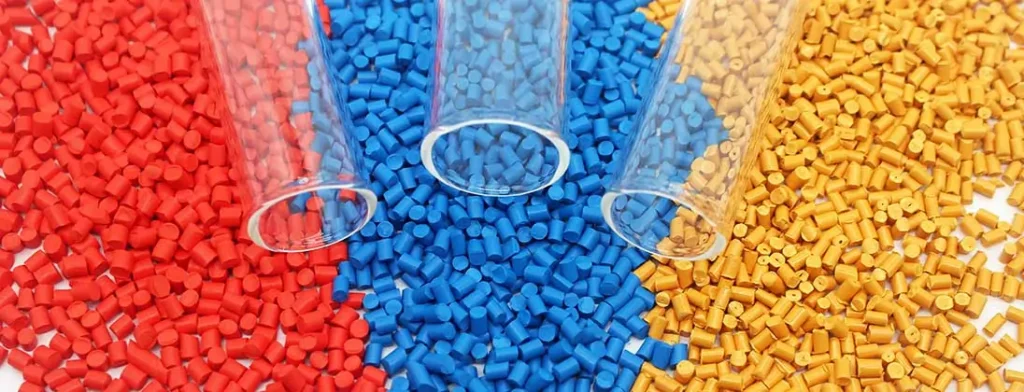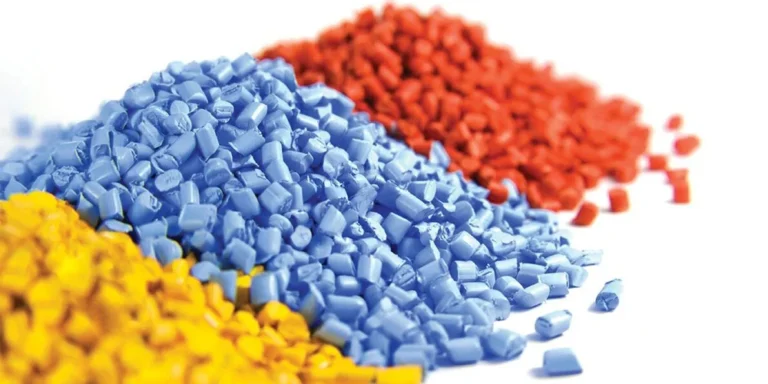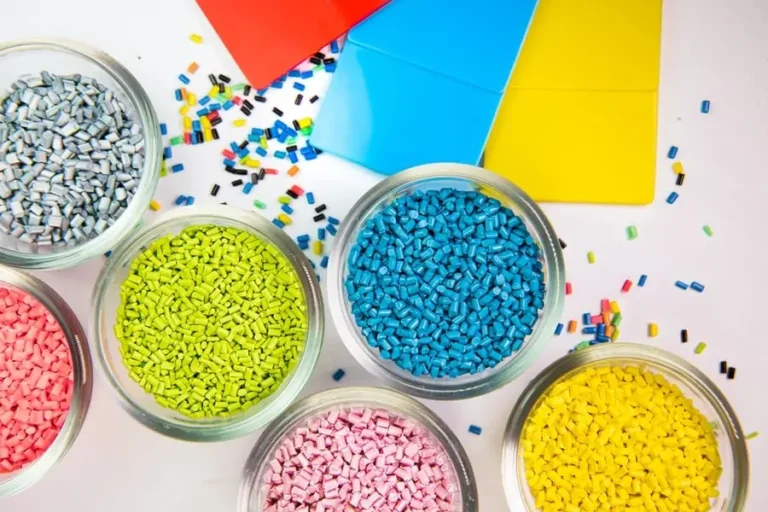Color masterbatches are a new type of polymeric material colorant that addresses the issues of uneven dispersion, heaviness, and environmental concerns associated with traditional color powders and pigments. Most of the colored plastic products we encounter in our daily lives are made using masterbatches. Masterbatches typically exist in granular form and are mixed with raw polymer materials during the manufacturing process of plastic molded parts to produce colored plastic products.
Color masterbatches are widely used across various industries. How many types of color masterbatches are there in total? Let’s explore this together.

Types of master batch
Color masterbatches can be classified based on different applications and material properties, including color effects, carriers, applications, color concentration, particle morphology, environmental requirements, composite functions, as well as industry, process, and quality characteristics. Today, we will primarily introduce different types of color masterbatches using conventional classification methods:
Classification by color effect
This is the most intuitive and common classification method. Below, I will introduce the characteristics and application scenarios of different color types of color masterbatches in a table format:
| Category | Specific Type | Core Composition/Key Property | Typical Applications |
|---|---|---|---|
| Conventional | Black Masterbatch | Carbon Black | Plastic bags, pipes, automotive parts |
| White Masterbatch | Titanium Dioxide (TiO₂) | Packaging film, appliance housings, pipes | |
| Gray Masterbatch | Blend of Black + White pigments | ||
| Colored Masterbatch | |||
| Organic Pigment-Based | Vivid colors, high tinting strength; Lower weatherability | Packaging, consumer goods, toys | |
| Inorganic Pigment-Based | High heat/weather resistance; Lower color saturation | Outdoor construction, engineering plastics | |
| Dye-Based | High transparency; Poor light/heat fastness | Thin-wall transparent products, fibers | |
| Special Effect | Metal Effects | ||
| Metallic (Silver/Gold) | Aluminum powder (Ag), Copper-zinc powder (Au) | Automotive trim, cosmetic packaging | |
| Pearlescent | Mica-based pearlescent pigments | Cosmetic packaging, premium decor | |
| Luminescent Effects | |||
| Fluorescent | UV-excited bright emission | Safety signs, advertising, toys | |
| Phosphorescent (Glow) | Long-persistence afterglow | Exit signs, glow-in-dark switches/toys | |
| Color-Shifting Effects | |||
| Thermochromic | Color shifts with temperature | Thermometers, anti-counterfeit labels | |
| Photochromic | UV-induced reversible color change | Sunglass lenses, security packaging | |
| Texture Effects | |||
| Marble/Granite | Incompatible multi-color blend | Decorative panels, countertops | |
Classification by Carrier
Color masterbatch carriers are thermoplastic resins whose primary function is to carry pigments, promote pigment dispersion during processing, and achieve perfect integration with the base resin. The suitability of the carrier directly affects the performance of the color masterbatch and the quality of the final plastic product. Let’s take a look at the characteristics and applications of different carriers.
Color Masterbatch Carrier Classification & Application Summary
| Category | Carrier Type | Matrix Resin | Key Property Requirements | Primary Application Areas |
| General Plastic Carriers | ||||
| Polyethylene (PE) | LDPE/LLDPE/HDPE | LDPE, LLDPE, HDPE | High melt flow, excellent dispersion, superior compatibility with PE | Films, pipes, containers, injection-molded parts, household goods |
| Polypropylene (PP) | PP Homopolymer/Copolymer | PP Homopolymer/Copolymer | Heat resistance (>200°C), high melt flow index (MFI) | Woven sacks, automotive bumpers, appliance housings, nonwovens, food containers |
| Polystyrene (PS) | GPPS/HIPS | GPPS, HIPS | Low-temperature processability, high gloss | Disposable tableware, appliance housings, foam packaging, toys |
| ABS | ABS Resin | ABS | Impact resistance, color stability | Electronics housings, toys, automotive interiors |
| PVC | PVC or Compatible Blends | Rigid/Flexible PVC | Low-temperature processing (160–200°C), thermal stability (requires stabilizers) | Profiles, pipes, wire/cable insulation, artificial leather, medical devices |
| PET (General Grade) | PET | Engineering-grade PET | Heat resistance (>280°C), low crystallinity interference | Engineering parts, electronic components |
| Engineering Plastic Carriers | ||||
| PA (Nylon) | PA6/PA66 | PA6, PA66, PA12 | Ultra-high temperature (280–300°C), low moisture (<0.05%), hydrolysis resistance | Gears, bearings, automotive components, electrical connectors |
| Polycarbonate (PC) | PC | PC | Extreme heat resistance (>300°C), high transparency (no impurities), anti-degradation | Light covers, transparent housings, water tanks, optical devices |
| POM | POM Homopolymer/Copolymer | POM | Heat resistance (190–220°C), low migration, low odor (formaldehyde control) | Precision gears, zippers, clips, medical instruments |
| PBT | PBT | PBT | Heat resistance (230–250°C), electrical insulation | Connectors, switches, bobbins, automotive sensors |
| PPO/PPE | Modified PPO | Modified PPO/PPE | Hydrolytic stability, dimensional stability | Electrical/electronic parts, automotive components, pump housings |
| Specialty Plastic Carriers | ||||
| PPS | PPS | PPS | Extreme temperature resistance (>300°C), chemical corrosion resistance | Aerospace components, corrosion-resistant pumps/valves |
| PEEK | PEEK | PEEK | Ultra-high temperature (350–400°C), high strength, biocompatibility | Medical implants, semiconductor tools |
| LCP | LCP | LCP | Self-reinforcing flowability, extreme heat resistance (>300°C) | Micro-connectors, precision electronics |
| PTFE | PTFE Micropowder | PTFE | Non-stick properties, ultra-corrosion resistance, extreme temperature (>400°C) | Seals, anti-corrosion coatings, high-end cookware |
| Fiber Carriers | ||||
| PET Fiber | Fiber-grade PET | PET Fiber | Ultra-fine dispersion (<1μm), heat resistance (290–300°C), low acetaldehyde | Beverage bottles, apparel fibers, industrial yarns |
| PP Fiber | Fiber-grade PP | PP Fiber | High flowability, spinnability compatibility | Nonwovens, carpets, sportswear |
| PA Fiber (Nylon) | Fiber-grade PA6/PA66 | PA Fiber | Heat resistance, low moisture sensitivity | High-end apparel, fishing nets, parachutes |
| Acrylic/Spandex | Custom carriers (e.g., PU-based) | Acrylic/Spandex | Elasticity compatibility, low-temperature coloring | Swimwear, athletic fabrics, medical bandages |
| Universal Carriers | ||||
| Universal Masterbatch | PE Wax / EVA | PE, PP, PS, EVA, etc. | Broad compatibility, high dispersion, cost-effectiveness | Non-critical consumer goods, packaging materials, small-batch production |
Classification by Application/Function
This method classifies products based on their performance characteristics and processing requirements across different industries. The primary function of color masterbatches is coloring, but depending on specific application scenarios and industrial requirements, they may serve specialized purposes such as flame retardancy, anti-static properties, UV resistance, whitening, pearlescent/metallic effects, and antimicrobial properties. Whether it’s application or functionality, we can achieve the desired color effects, performance, and processing requirements for plastic products through customized design solutions for color masterbatches, such as carrier resin selection, pigment/additive choices, formulation, and processing methods. Below are some common classifications for your reference.
Color Masterbatch Classification by Function & Application
| Product Type | Core Characteristics | Key Applications |
| Universal Color Masterbatch | Cost-effective base coloring | Daily plastic goods, packaging, household items |
| Ultra-High Dispersion Masterbatch | Nanoparticle dispersion, zero specks | Thin-wall products, high-gloss surfaces, synthetic fibers |
| High-Concentration Masterbatch | Pigment load: 70-80%, low dosage | Mass-produced single-color items (e.g., plastic chairs) |
| High-Heat Resistance Masterbatch | Stable at >300°C (pigment/carrier) | Engineering plastics, automotive under-hood parts |
| UV/Weathering-Resistant Masterbatch | Weather-fast pigments + UV absorbers | Automotive exteriors, outdoor construction, agri-films |
| Low-Migration Masterbatch | Minimized pigment bleeding, migration-compliant | Food packaging, toys, medical devices |
| Food/Medical-Grade Masterbatch | FDA/EU 10/2011/USP VI compliant, non-toxic | Food containers, pharmaceutical packaging |
| Flame-Retardant Masterbatch | Br/P/N-based FR additives, UL94 certified | Electronics housings, wire/cable, building materials |
| Anti-Static Masterbatch | Surface resistivity: 10⁹–10¹² Ω (surfactants) | Electronic packaging, textile machinery |
| Conductive Masterbatch | Volume resistivity: <10⁶ Ω (carbon black/metal powders) | EMI shielding, explosion-proof components |
| Antibacterial/Antifungal Masterbatch | Ag⁺/Zn²⁺ ions or organic biocides | Medical tools, sanitary ware, refrigerator liners |
| Optical Brightener Masterbatch | OBA (OB-1, KSN series) for blue-light emission | Premium packaging, white appliances, fibers |
| Matting Masterbatch | SiO₂/polymer wax additives, low-gloss finish | Automotive interiors, luxury packaging, electronics |
| Nucleating Agent Masterbatch | Organic phosphates/sorbitols for accelerated crystallization | PP products (enhanced stiffness, HDT*) |
| Foaming Masterbatch | Azodicarbonamide (ADC) chemical foaming agents | Foam boards, shoe soles, protective packaging |
| Antioxidant/Anti-Copper Masterbatch | Phenolic antioxidants + metal deactivators | Wire/cable, copper-containing parts, outdoor gear |
| Anti-Blocking & Slip Masterbatch | Silica/amide wax, COF* <0.3 | PE/PP films (packaging, industrial films) |
| Filler/Reinforcement Masterbatch | High-load CaCO₃/talc (>40%), cost-reduction | Construction profiles, industrial parts |
| Eco-Compliant Masterbatch | RoHS/REACH compliant, heavy-metal-free | Export-oriented electronics, automotive components |
| Biodegradable Polymer Masterbatch | PLA/PBAT-compatible carriers & additives | Compostable bags, mulch films |
| Recyclate-Specific Masterbatch | High opacity/pigment strength for contaminated recyclate | Recycled plastic products (pots, pallets) |
Classification by process
Different plastic processing processes have different requirements for the state of molten polymers and the final product. These requirements mean that color masterbatches take different forms in different processes. Let’s take a look at the characteristics and application scenarios of classification by process:
| Processing Technology | Key Characteristics | Typical Applications | Special Notes |
| Injection Molding Masterbatch | • High versatility • High MFI (Melt Flow Index) for flowability • Good pigment dispersion • High thermal stability (withstands shear heat) | • Appliance housings • Toys & consumer goods • Automotive parts • Electronic components | Requires excellent compatibility with base resin to avoid surface defects |
| Blown/Cast Film Masterbatch | • Exceptional dispersion • Minimal fish eyes • Superior HFP (High Filtration Pressure) performance • High weatherability (for specific uses) • Low migration | • Agricultural films • Food packaging films • Shopping bags • Medical films • Composite film layers | Most stringent dispersion requirements due to thin film thickness (typically 10-100μm) |
| Blow Molding Masterbatch | • Good dispersion • Uniform coloration (critical for large parts) • Environmental stress crack resistance (ESCR) | • Large containers (chemical drums, tanks) • Bottles (cosmetics, pharma) • Automotive fuel tanks | Color consistency is critical for large parts to avoid visible streaks |
| Extrusion Masterbatch | • Good dispersion • High weatherability (outdoor applications) • Thermal stability • Processing stability | • Window/door profiles • PVC pipes • Sheets/boards • Wire & cable jacketing • Wood-plastic composites | Outdoor profiles require UV resistance; cable applications need electrical properties |
| Fiber Spinning Masterbatch | • Most demanding specs: – Pigment particle size <1μm – Ultra-fine dispersion – Extreme heat resistance (>280–300°C) – Excellent HFP performance – Minimal fiber strength impact | • PP/PET/PA fibers (apparel, nonwovens) • Carpet yarns • Industrial fibers (ropes, tire cords) | Differentiated for melt spinning (PP/PA/PET) and solution spinning (acrylic) |
| Rotational Molding Masterbatch | • Powder form • Free-flowing properties • Long-term thermal stability (extended cycles) • Dispersion stability | • Large storage tanks • Playground equipment • Marine components • Traffic barriers | Must withstand slow heating/cooling cycles (typically 200–400°C) |
Conclusion
Through the above content, I believe you now have a basic understanding of the principles of color masterbatch classification and solutions for different industries. We are a professional manufacturer specializing in international color masterbatch color matching solutions. If you have any color matching issues, please contact us now. We have a professional team to provide you with solutions and free color matching services. We look forward to working with you!!!


